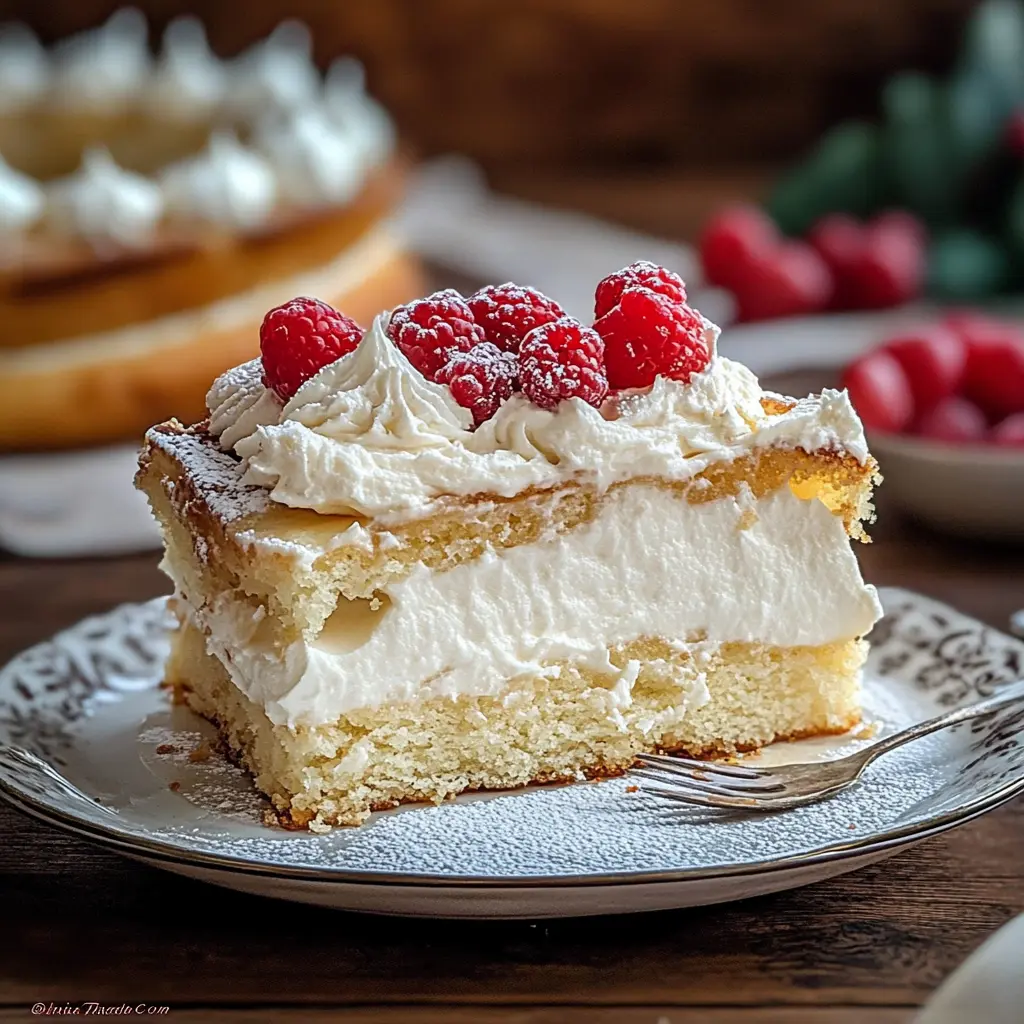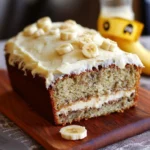Description: Papal Cream Cake, known as Kremówka Papieska in Polish, is a delightful and decadent dessert featuring layers of flaky puff pastry and a rich, creamy custard filling. This iconic cake is particularly famous because Pope John Paul II reportedly enjoyed it immensely in his younger days. It’s a dessert that combines simple ingredients into an unforgettable taste experience.
Why you will love this recipe: This recipe brings together contrasting textures and flavors that create a harmonious symphony on your palate. The buttery, crispy layers of puff pastry provide a perfect counterpoint to the smooth, velvety custard. It’s not just a dessert; it’s a culinary journey that offers a taste of tradition and indulgence. Whether you’re a seasoned baker or a novice in the kitchen, this recipe is straightforward enough to follow and rewarding enough to impress. Every bite is a sweet escape, making it perfect for special occasions or simply to brighten up an ordinary day.
Introduction: The Papal Cream Cake, or Kremówka Papieska, is more than just a dessert; it’s a piece of Polish history and culture. Its association with Pope John Paul II has elevated its status to iconic levels, making it a must-try for anyone interested in Polish cuisine. This recipe captures the essence of the traditional cake, providing you with all the necessary steps to recreate this masterpiece in your own kitchen. The process involves making your own puff pastry and custard, ensuring the freshest and most authentic flavors. Get ready to embark on a baking adventure that will tantalize your taste buds and leave you with a sense of accomplishment.
Ingredients:
For the Puff Pastry:
- 1⅓ cup (300g) unsalted butter, cold
- 2½ cups (300g) all-purpose flour, divided (200g and 100g)
- 1 medium egg
- ½ tablespoon vinegar (5% acidity)
- ⅓ cup warm water
For the Custard:
- 4½ cups (1L) whole milk
- 4 tablespoons unsalted butter
- 4 large egg yolks
- 2 whole large eggs
- 1 cup granulated white sugar
- 2 teaspoons vanilla sugar (or vanilla extract)
- 1 cup all-purpose flour
- ½ cup potato starch
- Powdered sugar, for dusting
Preparation:
Step 1: Prepare the Butter Mixture
In a bowl, combine 300g of cold unsalted butter with 100g of all-purpose flour. Knead the mixture together until it forms a smooth, pliable dough. This step is crucial as it creates the butter block that will be layered within the puff pastry, contributing to its characteristic flakiness. Once combined, flatten the butter mixture into a square approximately 2 cm thick. Wrap it tightly in plastic wrap and refrigerate for at least 30 minutes to allow the butter to firm up.
Step 2: Make the Dough
In a separate bowl, mix the remaining 200g of all-purpose flour with one medium egg, ½ tablespoon of vinegar, and ⅓ cup of warm water. Combine these ingredients until a soft, pliable dough forms, similar in consistency to pierogi dough. The vinegar helps to relax the gluten in the flour, resulting in a more tender pastry. Knead the dough for a few minutes until it is smooth and elastic. Shape the dough into a circle.
Step 3: Enclose the Butter
On a lightly floured surface, roll out the dough circle to a size large enough to enclose the chilled butter mixture. Place the chilled butter square in the center of the dough. Fold the dough over the butter, encasing it completely like an envelope. Ensure the edges are sealed tightly to prevent the butter from leaking out during the lamination process. This step is vital for creating distinct layers of butter and dough, which will puff up in the oven.
Step 4: Laminate the Dough
Roll the dough into a long rectangle, being careful not to press too hard and break the butter layer. Fold the rectangle into thirds, like folding a letter. This is the first “turn” of the lamination process. Lightly roll the folded dough again, wrap it in plastic wrap, and chill it in the freezer for 15 minutes. Repeat this rolling and folding process three more times, each time rotating the dough 90 degrees before rolling. The repeated folding and chilling create hundreds of thin layers of butter and dough, resulting in an incredibly flaky pastry.
Step 5: Bake the Pastry
Preheat your oven to 425°F (220°C). Divide the laminated dough in half. On a lightly floured surface, roll out each half into a large rectangle, about ¼ inch thick. Place the rectangles on baking sheets lined with parchment paper. Bake each sheet for approximately 15 minutes, or until they are golden brown and puffed up. Once baked, remove the pastries from the oven and let them cool completely on wire racks. Take one sheet of baked pastry and cut it into even squares; these will be used for the top layer of the cake.
Step 6: Make the Custard
In a large saucepan, combine 750 ml (approximately 3 cups) of whole milk, 4 tablespoons of butter, 1 cup of white sugar, and 2 teaspoons of vanilla sugar (or vanilla extract). Bring this mixture to a boil over medium heat, stirring occasionally to prevent scorching. While the milk mixture is heating, in a separate bowl, whisk together the remaining milk (250 ml or approximately 1 cup) with 4 egg yolks, 2 whole eggs, 1 cup of all-purpose flour, and ½ cup of potato starch. Whisk until the mixture is smooth and free of lumps.
Step 7: Cook the Custard
Once the milk mixture has come to a boil, slowly add the egg and starch mixture to the boiling milk, stirring constantly to prevent lumps from forming. Continue to cook the mixture over medium heat, stirring continuously, until it thickens into a smooth, creamy custard. This process may take several minutes, so be patient and keep stirring to ensure the custard is evenly cooked and doesn’t stick to the bottom of the pan.
Step 8: Assemble the Cake
On a large platter or serving dish, place the full sheet of baked pastry that you did not cut. Carefully pour the warm custard evenly over the pastry sheet, spreading it to cover the entire surface. Gently place the pre-cut pastry squares on top of the custard, arranging them neatly to create an even layer.
Step 9: Chill and Finish
Cover the assembled cake with plastic wrap and chill it in the refrigerator for at least several hours, or preferably overnight, to allow the custard to set completely and the flavors to meld together. Just before serving, dust the top of the cake generously with powdered sugar. Use a sharp, serrated knife to cut the cake into clean slices.
COOKING Rating: 5/5
Serving Suggestions: Serve the Papal Cream Cake chilled, garnished with a generous dusting of powdered sugar. It pairs perfectly with a cup of strong coffee or tea. For an extra touch, serve with fresh berries or a dollop of whipped cream.
Tips:
- Ensure all your ingredients, especially butter, are cold for the puff pastry.
- Work quickly when laminating the dough to prevent the butter from melting.
- Don’t overbake the pastry; it should be golden brown and puffed up.
- Stir the custard constantly to prevent lumps from forming.
- Chill the cake thoroughly before serving for the best texture and flavor.
Prep Time: 1 hour (plus chilling time)
Cook Time: 30 minutes
Total Time: 1 hour 30 minutes (plus chilling time)
Nutritional Information (per serving): (Note: Nutritional information is approximate and may vary based on specific ingredients and portion sizes.)
Calories: Approximately 450-550 kcal Protein: 8-10g Sodium: 150-200mg
Conclusion: The Papal Cream Cake, or Kremówka Papieska, is a delightful and historically significant dessert that is sure to impress. With its flaky pastry layers and creamy custard filling, it offers a perfect balance of textures and flavors. This recipe provides a straightforward approach to recreating this classic cake in your own kitchen, allowing you to share a piece of Polish culinary heritage with your friends and family. Enjoy the sweet taste of tradition!
Questions and Answers:
Q1: Can I use store-bought puff pastry instead of making my own?
A: Yes, you can use store-bought puff pastry to save time. However, keep in mind that homemade puff pastry will generally have a richer, butterier flavor and a flakier texture compared to store-bought versions. If you opt for store-bought, make sure to choose a high-quality brand.
Q2: What can I use if I don’t have potato starch?
A: If you don’t have potato starch, you can substitute it with cornstarch. Cornstarch has similar thickening properties and will work well in the custard. Use the same amount of cornstarch as you would potato starch.
Q3: How do I prevent lumps from forming in the custard?
A: To prevent lumps in the custard, make sure to whisk the egg yolks, whole eggs, flour, and potato starch (or cornstarch) together thoroughly before adding them to the boiling milk mixture. Also, add the mixture slowly while stirring constantly over medium heat. Continuous stirring is key to ensuring a smooth, lump-free custard.
Q4: Can I make this cake ahead of time?
A: Absolutely! In fact, the Papal Cream Cake is best made a day in advance. Chilling it overnight allows the custard to set completely and the flavors to meld together, resulting in a more delicious and cohesive dessert. Just make sure to dust it with powdered sugar right before serving to prevent the sugar from dissolving.
Q5: How should I store leftover Papal Cream Cake?
A: Store any leftover Papal Cream Cake in an airtight container in the refrigerator. It will stay fresh for up to 3-4 days. The puff pastry may soften slightly over time, but the cake will still taste delicious.




